 November 2: Here’s a lovely little house on Balliol Street that won’t be with us much longer. I’ve done no research to confirm this, but I believe this to be the farmhouse that stood on these lands prior to their subdivision. It was left on a large lot while new homes – mostly semi’s – were built around it. Now there’s an application at the Committee of Adjustment to allow its’ demolition, severance of the lot, and construction of two new “3-storey dwellings with front integral garages”. I am very sure that the applicants will point to the adjacent new-ish houses, which are an anomaly in the neighbourhood, as justification for the project. Mediocrity justifying schlock.
November 2: Here’s a lovely little house on Balliol Street that won’t be with us much longer. I’ve done no research to confirm this, but I believe this to be the farmhouse that stood on these lands prior to their subdivision. It was left on a large lot while new homes – mostly semi’s – were built around it. Now there’s an application at the Committee of Adjustment to allow its’ demolition, severance of the lot, and construction of two new “3-storey dwellings with front integral garages”. I am very sure that the applicants will point to the adjacent new-ish houses, which are an anomaly in the neighbourhood, as justification for the project. Mediocrity justifying schlock.
I have written about this process before, because I really don’t understand the thought process behind demolishing something with significant physical, monetary, or sentimental value only to replace it with something less valuable. This case is different since this is not “just another house”, but a house with historical value to the community and the city. I don’t understand how someone can look at it and decide that it’s just an old house that’s getting in the way of making a profit. Buildings like this have an intrinsic value that is greater than their monetary value. At what point do we decide that this sort of application is simply not acceptable ?
I indulge the guilty pleasure of watching BBC programs that show homeowners renovating and restoring heritage buildings in the British Isles. Inevitably, they are heritage listed, and “the Planners dictate what must be done” throughout the renovation. There seems to be little negotiation or appeal, and, even as a former Planner who would love to have the draconian power to dictate outcomes, this regime seems incredibly restrictive.* It wouldn’t be acceptable here, but surely there has to be a more efficient and effective way of preserving what little heritage we have remaining in our cities. As one consulting architect said to me many years ago: “If we don’t start protecting buildings from the 50’s and 60’s – never mind the 1800’s – there won’t be any left to get old…”
Well, here’s one building that truly is old and we are about to lose it. This situation, and the many others like it, leave me feeling sad and frustrated that there is not more public pressure to resist this sort of churlish destruction of our heritage. We are losing our past and accepting a mediocre future in return.
* * * *
* One large commercial project involving many millions of pounds of investment encountered a brown bat – one bat – in the roof, and all work was halted for several days while the bat was appropriately re-housed within the building.